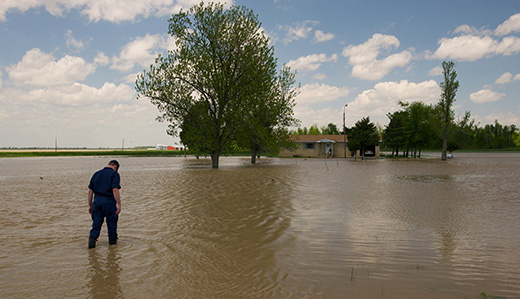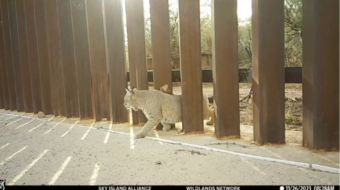
The right-wing National Review is rushing to instruct us that global warming has nothing to do with the record-breaking Mississippi River flood that is rolling toward New Orleans.
The funny thing is, it’s all based on quotes from experts who say a key cause of the flooding is over-development – in other words, the very “free market” enterpreneurship so beloved by the conservative crowd at the National Review.
So which is it? In fact, experts seem to agree, it’s not an either-or situation.
First, this fact: The Mississippi River crested at 47.79 feet on Tuesday at Memphis, the second-highest level on record, reports Andrew Freedman, a climate policy analyst with ClimateCentral. The water spilled through Memphis and surrounding areas, leaving hundreds homeless. As it continues south, it is drowning communities and farmland in Arkansas, Mississippi and Louisiana.
Freedman says two factors led to the flood. First is record rainfall in the Mississippi watershed: “the heavy rain that fell during April in the Ohio Valley, where six states – Illinois, Indiana, Kentucky, Ohio, Pennsylvania, and West Virginia – recorded their wettest April since instrument records began 117 years ago. Nine states recorded their wettest February through April period on record, according to a report released Monday by the National Oceanic and Atmospheric Administration (NOAA).” On top of that, he says, snowmelt added more water to the river.
Climate change cannot be blamed as the direct cause of the flooding, says Freedman. “But,” he writes, “scientists have detected large-scale trends indicating that extreme precipitation events are becoming more likely as temperatures warm in response to increasing amounts of greenhouse gases in the air.”
“This means that heavy rainfall events are more frequent than they used to be, in part because a warmer atmosphere holds more moisture that can be wrung out by storm systems,” he explains.
Greenhouse gases are things like carbon dioxide and methane, which seal in heat close to the earth’s surface, leading to global warming. The increase in greenhouse gases in the atmosphere, scientists overwhelmingly agree, is primarily due to industrial and automobile emissions.
Freeman writes, “Scientists are working to detect the ‘fingerprint’ of climate change in specific extreme weather events, and their methods are still in their infancy. It will take many months for studies to be completed on whether climate change may have made April’s heavy rains more likely.” But several recent studies show a link between climate change and extreme rainfall.
So, global warming may well have something to do with the Mississippi flood. But it’s not the only factor.
The National Review attempt at global-warming debunking consists of a repost of an ABC News report headlined “Mississippi Rising: Critics Say High Water Result of Man Not Mother Nature.” In fact the experts interviewed by ABC suggest a variety of factors are involved, including those record rainfalls that climate scientists are researching.
H.J. Bosworth Jr., civil engineer and director of research for Levees.org, told ABC, “This is largely a man-made disaster – to point it only to rainfall is naïve. Yes, there was lots of rainfall, but there was also lots of development. Every time you build a parking lot or a Wal-Mart you add to the burden of the drainage system and all that drainage goes into the Mississippi River.”
“If the rainfall increased in a forest the forest is going to suck up 90 percent of that rainfall. But if it happens in a urban area the pavement and roofs aren’t going to suck up anything,” he said.
At the same time, Robert Criss, professor of earth and planetary sciences at Washington University in St. Louis, said, “The rivers need some room and we are getting that message explained very clearly to us year after year. It’s time we smelled the coffee. There is a lot of evidence that floods are not only getting deeper and more severe, but also more frequent.”
Criss said it is necessary to “get people and infrastructure out of the flood plains rather than walling off more of the flood plains. Currently, we are putting more infrastructure in the flood plains. We have square miles and square miles of flood plains that are now huge shopping malls or other things.”
At American Rivers, a conservation organization, Amy Souers Kober cites a disturbing statistic. “We have lost 35 million acres of wetlands in the upper Mississippi basin,” she writes. “That’s an area the size of Illinois. Think of all the floodwaters those wetlands could have held.”
American Rivers and others are part of a growing movement to stop trying to constrict rivers and instead let them follow their natural course, keeping open space for flood plains. The Washington Post reports that places like Cedar Rapids, Iowa, Napa, Calif., and Piece County, Wash., which have had major floods, are taking steps to move development away from their river edges and restore the water’s natural paths. Cedar Rapid is opening up a “floodable greenway,” while Napa is creating a “living river.”
Photo: A flooded home and driveway along the Mississippi River, May 3. U.S. Army Corps of Engineers











